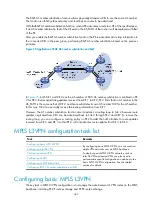
248
Complete the following tasks to configure basic MPLS L3VPN:
Task Remarks
Required
Associating a VPN instance with an interface
Required
Configuring route related attributes for a VPN instance
Optional
Configuring a tunneling policy for a VPN instance
Optional
Optional
Configuring routing between PE and CE
Required
Configuring routing between PEs
Required
Configuring routing features for BGP VPNv4 subaddress family
Optional
Configuration prerequisites
Before you configure basic MPLS L3VPN, complete the following tasks:
•
Configure an IGP for the MPLS backbone (on the PEs and Ps) to achieve IP connectivity
•
Configure the MPLS basic capability for the MPLS backbone
•
Configure MPLS LDP for the MPLS backbone so that LDP LSPs can be established
Configuring VPN instances
By configuring VPN instances on a PE, you can isolate not only VPN routes from public network routes,
but also routes of a VPN from those of another VPN. This feature allows VPN instances to be used in
network scenarios besides MPLS L3VPNs.
All VPN instance configurations are performed on PEs or MCEs.
Creating a VPN instance
A VPN instance is associated with a site. It is a collection of the VPN membership and routing rules of its
associated site. A VPN instance does not necessarily correspond to one VPN.
To create and configure a VPN instance:
Step Command
Remarks
1.
Enter system view.
system-view
N/A
2.
Create a VPN instance and
enter VPN instance view.
ip vpn-instance
vpn-instance-name
N/A
3.
Configure an RD for the VPN
instance.
route-distinguisher
route-distinguisher
A VPN instance takes effect only
after you configure an RD for it.
4.
Configure a description for
the VPN instance.
description
text
Optional.
The description should contain the
VPN instance's related
information, such as its relationship
with a certain VPN.






























